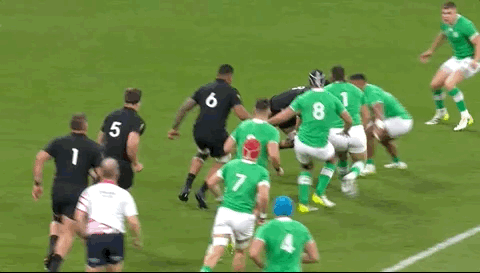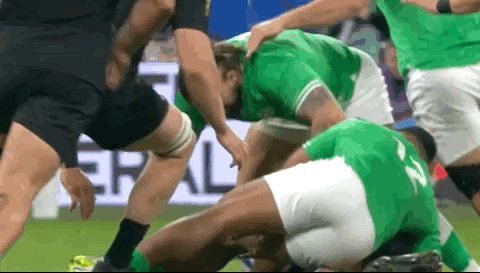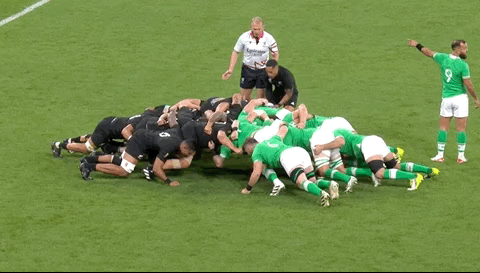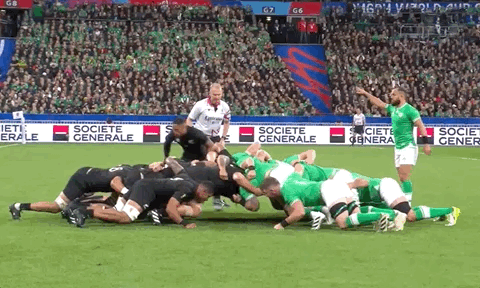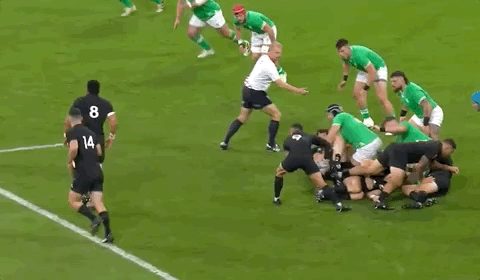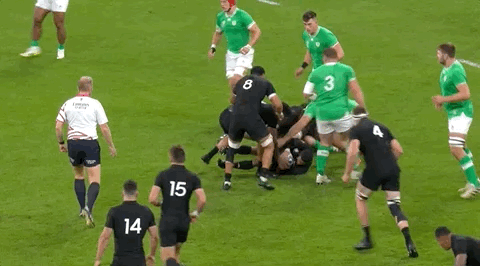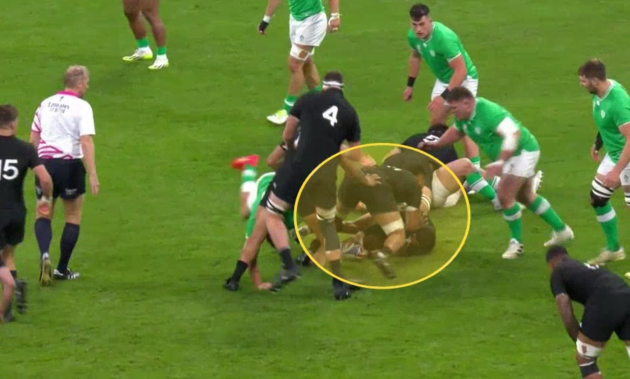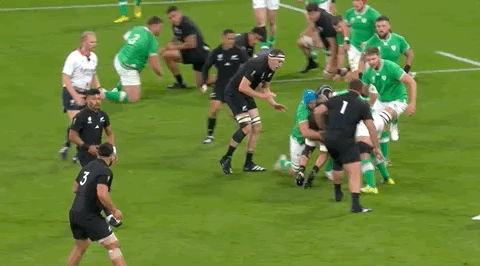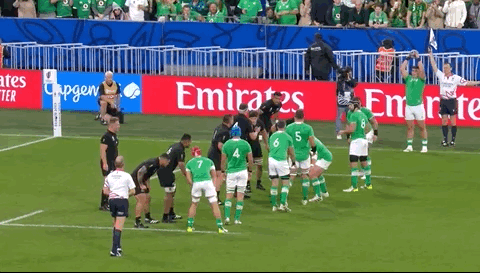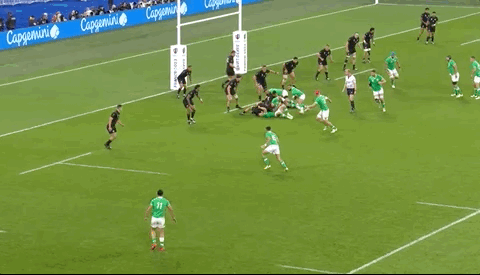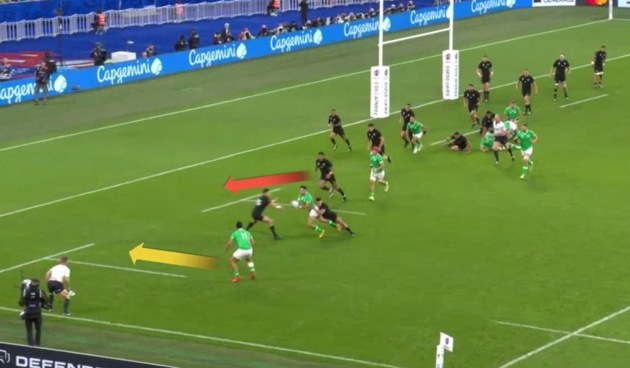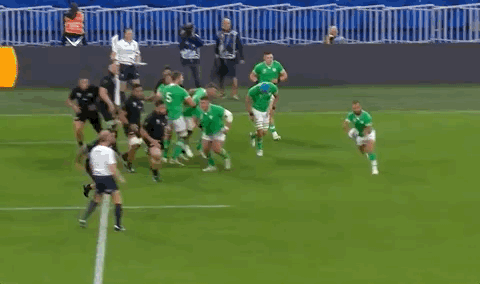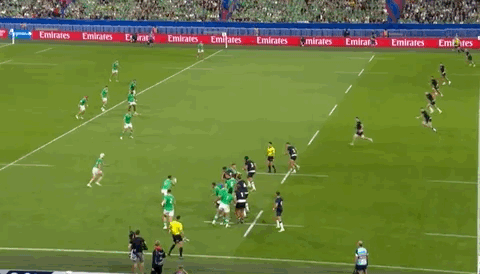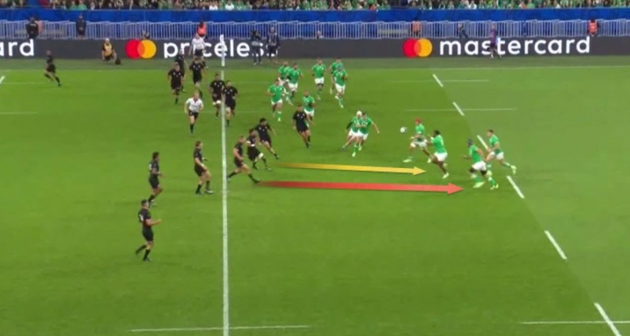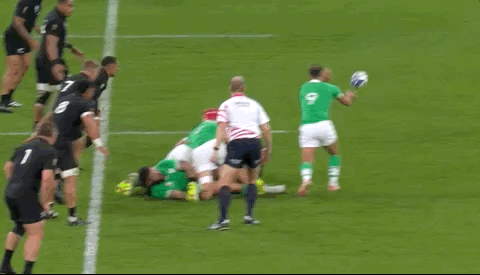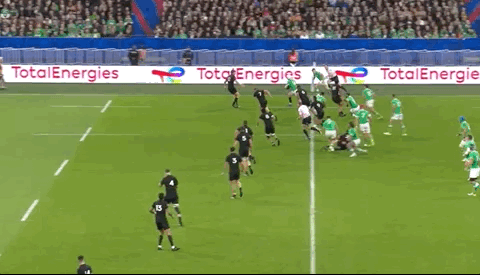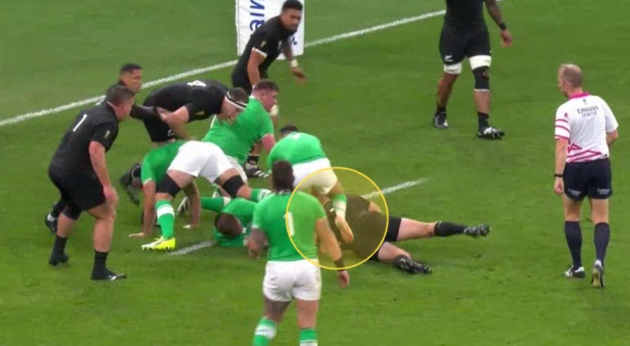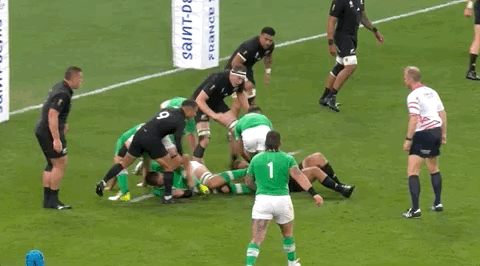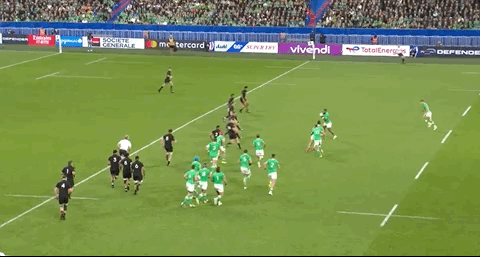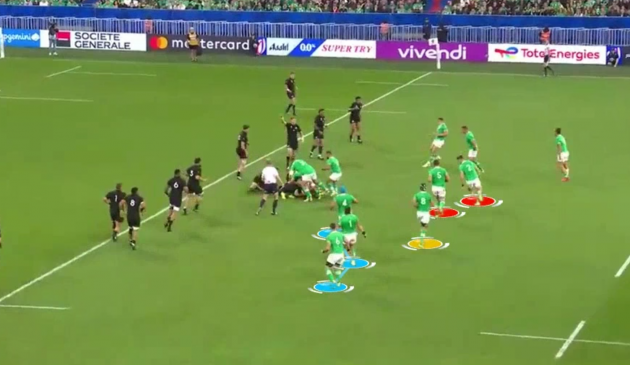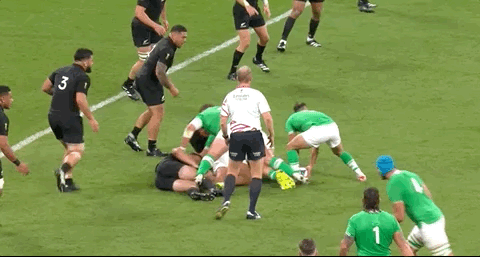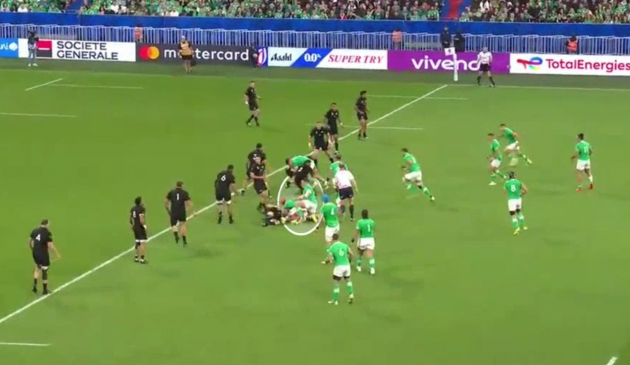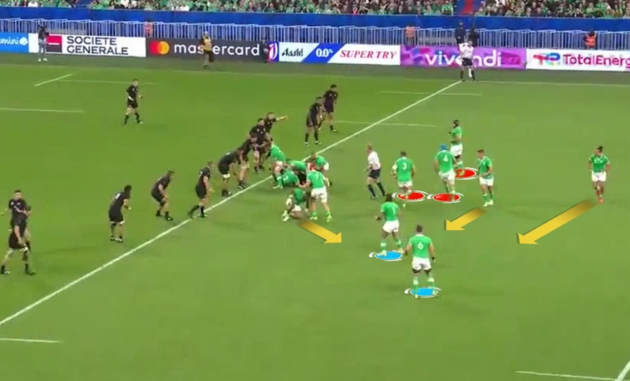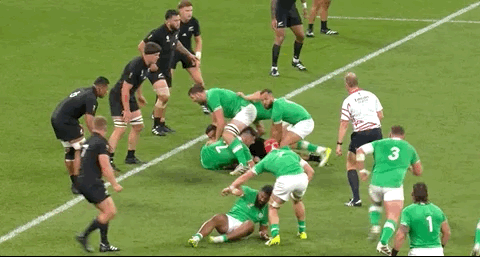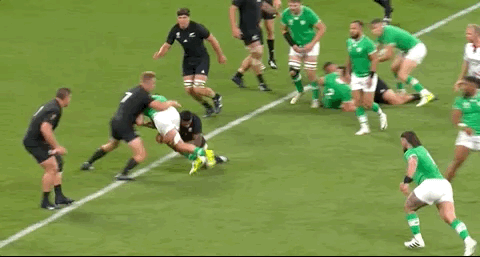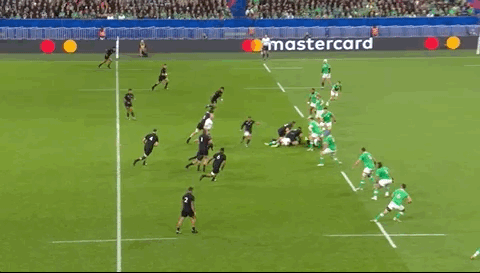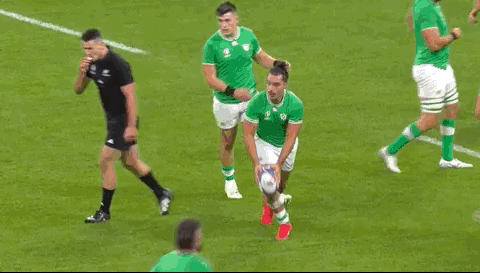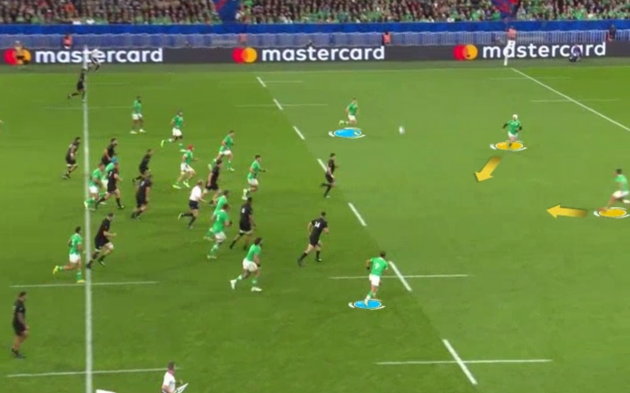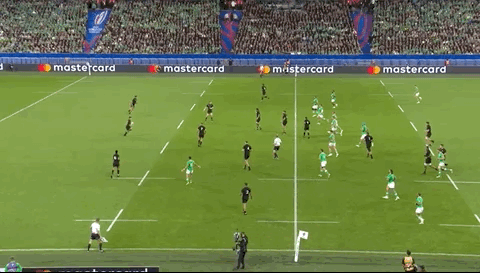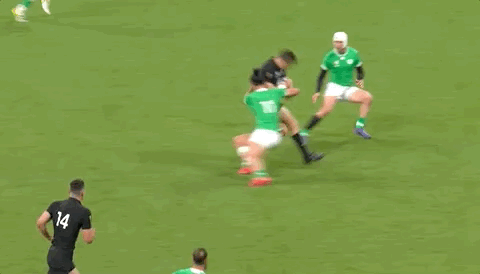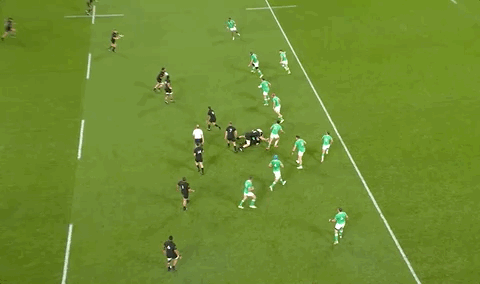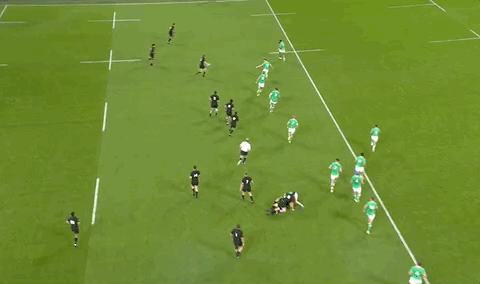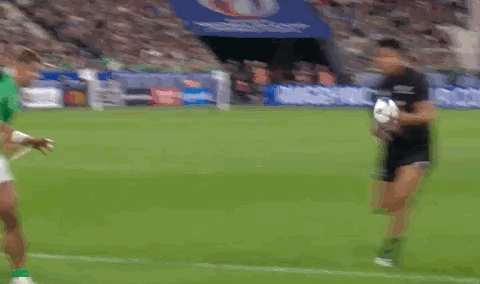13-0 DOWN AFTER the opening quarter of a World Cup quarter-final is not the place you want to be.
While Ireland played some brilliant rugby thereafter in last night’s dramatic 28-24 defeat to New Zealand, those opening 20 minutes were undeniably damaging.
Andy Farrell’s men showed their characteristic belief to get themselves back into the contest, but they are likely to have big regrets about how they lost the opening exchanges of this battle to what proved to be a brilliant All Blacks team.
Just 19 seconds in, Ireland gave up the kind of penalty that they would have discussed avoiding at all costs.
Ireland have just kicked off to start the game and the All Blacks will have to exit here, giving Farrell’s men an early chance to attack, but loosehead prop Andrew Porter’s discipline slips.
No doubt eager to make an early impact, he plays the ball while off his feet.
Porter jackals looking for the turnover and though he’s clearly not on his feet, he can’t resist ripping the ball clear. It’s one of 10 penalties conceded by Ireland in this game, exactly the same number as New Zealand gave up.
This one is an easy decision for referee Wayne Barnes and the Kiwis get a chance to kick up the left touchline.
However, Jordie Barrett makes a poor connection with his touch finder, only reaching the 10-metre line, then Aaron Smith throughs a rare bad pass off the lineout, with Richie Mo’unga following up with a mishit, shallow up-and-under. Garry Ringrose can’t quite gather it and knocks on, meaning the first scrum of the game just two minutes in.
Ireland go on the attack as Smith feeds the ball in, but they’re penalised and it’s Porter who gets pinged again.
It’s a frustrating one for Ireland, who feel they’ve done enough to win the penalty and probably open the scoring from the tee, but Barnes gets a call from assistant referee Christophe Ridley, who tells him, “[Penalty against] green, straight across the scrum, loosehead angle.”
It’s clear that Ireland generate forward momentum here. But for the call from the touchline, Barnes may have given the penalty to Ireland.
Porter and Ireland would argue that All Blacks tighthead Tyrel Lomax was the one who turned in here under the intense pressure of a well-timed Irish shunt. Their point of view would likely be that Porter had nowhere else to go once Lomax had turned in first.
Porter doesn’t step out to his left to generate an angle on Lomax and we can see above that he only drives inwards once Lomax has lost the power on his right-hand side, with his bind drawing back away from Porter before the Irish loosehead goes forward.
But the call goes against Ireland, with the New Zealand back five doing a good job of exaggerating the angle by chasing through after their front row have gone backwards. Barnes trusts his assistant referee. Sometimes those calls go against you. That’s rugby.
As an aside, New Zealand are clever a few minutes later as Richie Mo’unga lines up a penalty shot at goal. Hooker Codie Taylor asks Barnes, “Are you happy with loosehead’s [Porter's] angle on that last scrum?” and Barnes reminds him, “That was a penalty.” It’s Taylor’s way of accentuating the point.
Back to the opening minutes, Ireland find themselves defending just outside their own 22. What follows is a remarkable 30-phase passage that lasts 3 minutes and 18 seconds. The average passage of play in this World Cup has lasted 28 seconds.
What’s even more staggering is that the final passage of this game lasted for an astounding 6 minutes and 18 seconds as Ireland nearly found a way to pinch the win.
But in both cases, New Zealand came out on top. In the early battle, they were narrow and direct as they laid down a physical challenge that Ireland largely answered. There were some huge collisions such as the one below as Tadhg Furlong tackles Ethan de Groot.
New Zealand’s ball retention and accuracy at the breakdown is outstanding in this passage, even at times when it looks like Ireland will finally force a turnover.
The example below comes on 19th phase as James Lowe leads a counter-rucking effort.
Lowe is successful in blasting Leicester Fainga’anuku away and suddenly opportunity beckons for Ireland.
But Ardie Savea recognises the threat now posed by Furlong following in and he gets into a low position over the ball, without flopping straight off his feet, and braces himself for the big impact.
Even with Iain Henderson following in behind Furlong, there is no budge from Savea, who shows huge strength to resist until Brodie Retallick arrives in support.
New Zealand retain possession and continue to grind through exhausting phases until finally Ireland crack with a penalty concession.
It’s Tadhg Beirne who’s penalised for not rolling away from his tackle.
Beirne lands in a bad position here, down on top of the ball as he brings Savea to ground.
New Zealand are smart in highlighting Beirne’s position, with de Groot using his legs to pin Beirne where he is, while Savea pushes the ball into Beirne.
As we pointed out after the win over South Africa, this is the kind of stuff Ireland also do well. What goes around comes around, and clearly the biggest issue is where Beirne lands.
It’s another easy penalty for Barnes and Mo’unga makes it 3-0 to the All Blacks to ensure they come away from a bruising passage of play having drawn the first blood.
Ireland respond well as their first attack of the game sees Ringrose make ground up the right-hand side, where Savea is penalised for not rolling away.
Ireland opt to go down the touchline and their lineout just about survives an assault in the air from Retallick.
It’s an astounding jump from Retallick, as well as a brilliant lift from Scott Barrett and Ethan de Groot, and he just about gets a hand to what is a near-perfect throw from Dan Sheehan.
Henderson reacts well and goes from lifting Peter O’Mahony to stretching his right hand up in order to bat the ball back to scrum-half Jamison Gibson-Park.
Ireland can attack and there are carries from Bundee Aki and Porter before they look for the final blow out on the left.
Gibson-Park’s pass is superb, allowing Hugo Keenan to just fade outside Will Jordan, in turn drawing Beauden Barrett in onto him.
Jordan still gets the tackle in on Keenan and with Barrett closing fast, there is huge pressure as Keenan looks to offload to Lowe.
If this ball goes to hand, it’s difficult to see Lowe not scoring. Rieko Ioane [red] is hunting across from the inside and he’s very quick, but Lowe would probably still have enough time, space, and power to get the ball down.
This is just one example of several in this game where the fine margins don’t go Ireland’s way. Keenan’s offload under intense pressure is high and behind Lowe, who is flat to his fullback. The ball goes loose and bobbles into touch.
New Zealand then nail their five-metre lineout under big pressure from O’Mahony. The Kiwis had a flawless lineout performance with a 100% return on their eight throws, while they also turned over two Irish throws.
An exchange of kicks follows and leaves Ireland with a lineout to attack from on the halfway line, from where Sam Cane and Savea deliver a brilliant bit of defence.
The Irish lineout play is one that New Zealand are familiar with, having done their homework.
The example below comes from last weekend’s win against Scotland.
The difference is that Scotland’s defensive assignments mean that out-half Finn Russell is the man tackling Caelan Doris here, having also sat off and allowed Doris to pick up speed.
The Kiwis ensure that it’s Cane, their best tackler, who targets Doris.
Savea is on Cane’s inside and provides assurance that he’s going to take Aki [yellow below], leaving Cane to push onto Doris [red].
And Cane is extremely assertive with his defensive actions, coming forward and closing the space on Doris before he plants to tackle.
There is the chance of a pass out the back from Aki but Cane is focused on nailing Ireland’s number eight, which he does. It’s a fine read from Cane.
It’s also a huge tackle from Cane, who dips low and drives his right shoulder into Doris’ upper legs, wrapping his arms tightly in behind each knee to completely take his leg drive out of the equation. Cane drops Doris onto his back, exposing the ball for Savea to target.
Cane also drives Doris away from Aki, his closest support, and the Ireland centre slips on Cane as he tries to win the race to the breakdown. Savea is accurate in getting straight onto the ball before Josh van der Flier arrives.
Having had to work all the way around Aki and Cane, van der Flier can’t generate enough power to shift Savea and Barnes awards the Kiwis a well-earned turnover penalty. From just inside the Irish half, Jordie Barrett smashes over the three points for 6-0 with 14 minutes gone.
As was the case so often in this game, Ireland responded with some incisive attack.
Indeed, they made seven linebreaks in this game to New Zealand’s six, with Hansen bursting up the right on this occasion…
… before offloading inside to Gibson-Park, who finds Ringrose racing into the 22.
New Zealand have to scramble hard, which they did well in this game, but Ireland make further gains wide on the left as Lowe shows his power in the carry.
Again, Ireland are within sight of the tryline only to turn the ball over.
Henderson has just carried when Gibson-Park arrives at the breakdown and sees Cane on the ground having made the tackle.
Gibson-Park pushes his knee into Cane, probably with the intention of helping to ensure a penalty for Ireland for Cane not rolling away. We spoke about how Ireland did this against South Africa, when Gibson-Park helped to win a penalty by highlighting the positioning of the tackler.
Whether Barnes has studied that or it was flagged to him by New Zealand, he seems well aware of Gibson-Park’s intention and doesn’t award a penalty against Cane, who rolls away to the side in the next split second.
To be fair to Gibson-Park, Cane’s presence does make it difficult to clear the ball as quickly as possible with a pass or carry, but his slight delay gives Retallick time to come forward from an onside position, wrap him up and fling him to the ground, show enough of a release, and jackal.
As Retallick is manhandling him, Gibson-Park is appealing to Barnes and seems to shout, “F**king hell” but play continues and the Irish scrum-half might have done more to resist the efforts from the big Kiwi lock were he not thinking of winning a penalty.
It’s another call that Ireland will feel could have gone their way for Cane being in that channel but Barnes was happy with the All Blacks’ captain’s effort.
Retallick makes the clean turnover, New Zealand kick clear to touch and as Ireland remonstrate with him, Barnes says, “Jamison, don’t just stand there with your hands on the ball when the ball’s available. You’re just slowing your own ball down then.”
Ireland have the ball back at the next lineout but they give up another turnover, this time far too easily. Farrell’s men seem to be completely confused about their play call here and they give up a very poor turnover at the breakdown.
Aki carries on first phase, with van der Flier and Furlong getting to that breakdown.
The confusion seems to set in immediately as Henderson and Sheehan [red below] work around the corner to the right, while Beirne, Porter, and O’Mahony [blue] hold as a pod on the left-hand side.
Doris [yellow above] seems to hover in between, neither holding nor folding.
Gibson-Park plays a short pass to Sheehan on his right but the timing is clearly off as Sheehan has to almost stop to take the ball, doing well to get moving forward again.
As Sheehan is carrying the ball, there’s another indication that things are unfolding badly.
Furlong, who is getting up from the previous ruck, glances to his left and angrily shouts, “Get around the f**king corner!”
So as Henderson and Ringrose get to the breakdown as Sheehan is carrying, we see that Furlong, Beirne, and Doris [red below] now work around the corner to the right.
Porter and O’Mahony [blue] are still holding on the left and now Sexton and Lowe [yellow arrows] are starting to swing back to that side as Aki [also yellow] gets up off the ground in order to retreat into the attacking line on that side.
But despite Aki literally running away from him and none of his team-mates being close to him, the ball goes to van der Flier, who has only just got up himself. Gibson-Park doesn’t chase after passing to the extremely isolated van der Flier.
With Kiwi blindside flanker Shannon Frizell chopping in low on van der Flier, Cane goes in around the upper body and then has time to release and jackal onto the ball for a turnover penalty.
Cane deals superbly with the big impact of Porter arriving in after a big run-up.
Rarely have we seen such a disorganised attack from Ireland as this three-phase passage.
New Zealand deserve credit for this turnover, of course, but it’s about as generous a gift as you will see in a game of this level.
Again, the Kiwis can lift the pressure by clearing the penalty kick into touch and they use that lineout platform to kick what is clearly intended to be a contestable bomb from the middle of the pitch.
Smith gets too much on his kick, though, and it’s a straightforward mark for Lowe under relatively little pressure.
As Lowe then glances upfield, he can see a swathe of inviting grass in the right-hand side of New Zealand’s backfield.
He uses his powerful left boot to launch the ball into that space, with the potential for a 50:22 if he really nails it.
However, Mo’unga does an excellent job of fielding it on the full, using all of his pace to scamper across the pitch from a central position and deny Ireland the bounce of the ball they’d have hoped for.
Mo’unga weighs up the option of a return kick but now the Kiwis decide that this is the kind of ‘transition’ situation in which they are truly lethal. When game breaks up, the All Blacks are brilliant.
Mo’unga passes infield to fullback Beauden Barrett, the master of transition play, and he has lots of time on the ball to pick his poison. Ireland will surely feel they could have chased harder in midfield here, putting more pressure on him, as the chip space beckons for Barrett. Indeed, Keenan looks frustrated that there isn’t more urgency in the chase.
Ireland, like many teams, don’t operate with a ‘sweeper’ set up behind the defensive frontline, instead preferring to have another body in the frontline to get more width and linespeed there.
Ireland’s hope is that defenders close to the edge [blue below] will get an early read and drop off to cover chips, or that their backfield defenders [yellow below] will be able to close up and win the race to the chipped ball.
With the benefit of hindsight and considering New Zealand have two top-class chippers in Barrett and Mo’unga, perhaps Ireland could have had more of a safety valve in behind but that’s not generally how they defend.
It’s probably underappreciated how difficult chip kicks are to do. They’re easy to undercook or overcook. It takes great skill to get right but Barrett is a true expert and his searing pace means that he is good at retrieving the ball. That’s what happens here.
Barrett just beats Lowe to the ball and ships a massive hit in the split second after winning the race.
The Kiwi fullback is immediately in danger of being turned over by Hansen, but watch his excellent work on the ground to keep the ball clear of Hansen.
Barrett rotates his left shoulder over the ball to deny Hansen a clear sight of it, then shives it backwards through his legs to ensure scrum-half Smith gets an instant chance to move it away against an Irish defence that is now scrambling to recover.
Smith finds Lomax, with the tighthead prop calmly and accurately moving the ball onto Jordie Barrett.
New Zealand are lethal in these situations because they’re skillful and fast, but also because they work hard.
Watch try-scorer Fainga’anuku bursting up from the backfield below, having dropped into it when Beauden Barrett chipped, to get to Jordie Barrett’s outside shoulder here.
Fainga’anuku’s work-rate and awareness turns this into a 3-on-2 situation on the edge, with Doris always struggling to get out to Jordie Barrett.
That leaves Ringrose and Aki doing their utmost to rescue the situation but the Kiwis are clinical.
Jordie holds Ringrose with multiple dummy pumps of the ball, meaning that even when Ringrose manages to jockey off towards Fainga’anuku after Barrett passes, Ringrose can’t actually tackle the Kiwi wing.
Aki manages to sit off Fainga’anuku and jockey out towards Ioane as Fainga’anuku then passes, but Aki is stretching to tackle too and that means Ioane can calmly flick the ball back inside to Fainga’anuku just before Aki makes contact.
It’s the prototypical blink-and-you’ll-miss-it New Zealand try as they shred Ireland in the space of 15 seconds.
Although Mo’unga can’t convert, it leaves Ian Foster’s side 13-0 ahead with only 20 minutes of the quarter-final gone.
While Ireland produce lots of brilliant rugby in the next 60 minutes and come close to a dramatic winning score in the thrilling endgame, they will have regrets about not making a more positive start.


